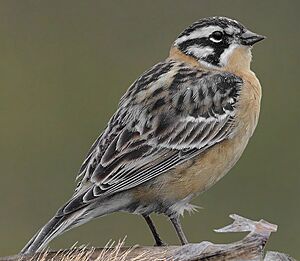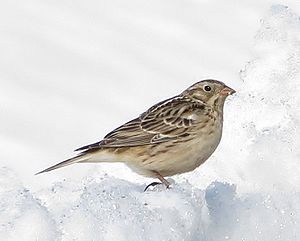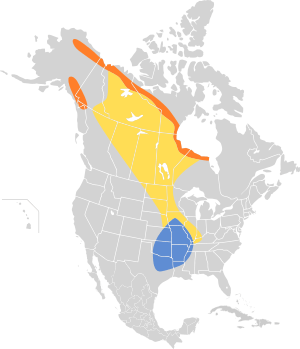Smith's longspur facts for kids
Quick facts for kids Smith's longspur |
|
|---|---|
 |
|
| Male | |
 |
|
| Female | |
| Conservation status | |
| Scientific classification | |
| Genus: |
Calcarius
|
| Species: |
pictus
|
 |
|
The Smith's longspur (Calcarius pictus) is a small bird that belongs to the Calcariidae family. This family also includes other types of longspurs. These birds love open spaces and grassy areas. They spend their summers breeding in northern Canada and Alaska. When winter arrives, they fly south to the United States. Smith's longspurs mostly eat seeds found on the ground, but they also enjoy insects during the warmer months.
Contents
Meet the Smith's Longspur
This interesting bird is known for its unique patterns and habits. It's a ground-dwelling bird, meaning it spends most of its time on the ground, looking for food and building its nest.
What Does It Look Like?
Smith's longspurs have short, cone-shaped beaks, which are perfect for eating seeds. Their backs are streaked with different colors, and their tails are dark with white feathers on the outer edges.
Male Birds in Summer
During the breeding season, male Smith's longspurs look very striking. They have a bright orange throat, neck, and belly. This orange color stands out against a cool black and white pattern on their face. They also have noticeable white patches on their wings.
Female and Young Birds
Female and young Smith's longspurs have a softer look. Their undersides are a light tan color with gentle streaks. They have dark caps on their heads and brown wings. Their faces are lighter in color. The tail pattern, with its dark center and white outer feathers, stays the same for all ages.
Size and Weight
These birds are quite small.
- Length: About 15 to 17 centimeters (6 to 6.7 inches) long.
- Weight: They weigh between 20 and 32 grams (0.7 to 1.1 ounces). That's about as much as a few quarters!
- Wingspan: Their wings can spread up to 25 centimeters (about 10 inches) wide.
Where Does It Live?
Smith's longspurs make their homes in open, grassy areas near the tree line in northern Canada and Alaska. This is where they raise their young.
Winter Travels
When winter comes, these birds travel south. They gather in large groups in open fields, sometimes even at airports, in the south-central United States. Their journey is a bit like an oval shape. In spring, they fly north through Illinois. In the fall, they head south over the Great Plains. This journey is called migration.
How Do They Behave?
Smith's longspurs are social birds, especially outside of the nesting season. They often gather in flocks to find food.
Nesting and Young
These birds build their nests in small groups, almost like tiny neighborhoods. The female bird builds a cup nest on the ground using grass. She usually lays three to five eggs. Both parents, and sometimes more than one male, help feed the baby birds. They work together to make sure the young ones get enough to eat.
What Do They Eat?
Smith's longspurs mostly search for food on the ground. Their main diet is seeds. However, in the summer, when there are lots of insects and spiders around, they prefer to eat those. Young birds are mostly fed small creatures like spiders, insects, and tiny snails. Sometimes, they might also swallow small bits of plants that get stuck in their mouths.
Their Special Sounds
The song of the Smith's longspur is a sweet, musical sound that ends with a little twist. Some people say it sounds a bit like the chestnut-sided warbler. When they make a call, it's a dry, rattling sound. It's shorter and drier than the call of a female brown-headed cowbird and also different from the Lapland longspur's call.
How Did It Get Its Name?
The Smith's longspur has an interesting story behind its name! It was first described in 1831 by a naturalist named William Swainson. He mistakenly called it the "Painted Bunting," but that name already belonged to another bird.
A New Name
Later, in 1844, a famous bird artist named John James Audubon gave the bird its current name. He named it in honor of his good friend, Gideon B. Smith. That's how the Smith's longspur got its unique name!
See also
 In Spanish: Escribano de Smith para niños
In Spanish: Escribano de Smith para niños


